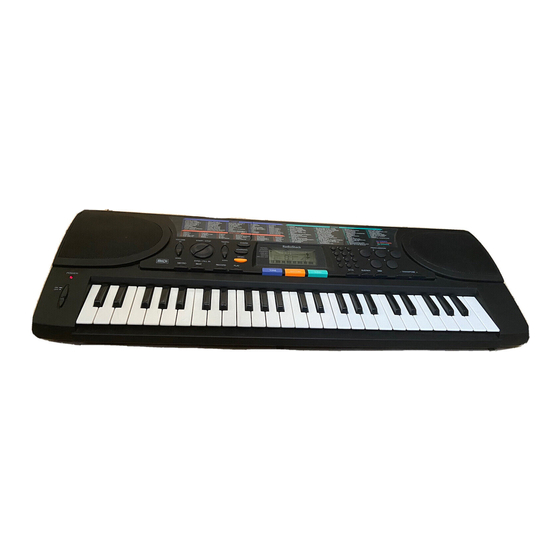Table of Contents
Advertisement
Advertisement
Table of Contents

Summary of Contents for Radio Shack MD500
- Page 1 MD500 MIDI Keyboard with Mini-Size Keys...
-
Page 2: Table Of Contents
CONTENTS Features ... 2 The FCC Wants You to Know ... 2 Preparation ... 3 Connecting Power ... 3 Using Batteries ... 3 Using AC/DC Power ... 3 Connecting Headphones ... 4 Listening Safely ... 4 Connecting an External Amplifier ... 4 A Quick Look at Your Keyboard ... -
Page 3: Features
Note: This Owner’s Manual explains how to use this electronic keyboard. It does not teach music. RadioShack, Adaptaplug, and RadioShack.com are trademarks used by RadioShack Corporation. THE FCC WANTS YOU TO... -
Page 4: Preparation
Preparation To connect a MIDI device to your keyboard, see “Making the MIDI Connections” on Page 12. CONNECTING POWER You can power your keyboard in any of these ways: • internal batteries • standard AC power using an optional AC adapter •... -
Page 5: Connecting Headphones
before you disconnect it from the key- board. 1. Slide POWER 2. Set the AC or DC adapter’s voltage switch to 9V. 3. Insert the Adaptaplug adapter into the adapter’s cord so it reads + TIP. 4. Connect the AC or DC adapter’s bar- rel plug to the jack on the... -
Page 6: A Quick Look At Your Keyboard
A Quick Look at Your Keyboard SYNC/ VOLUME FILL-IN Speaker START/ TONES STOP List METRO POWER BEAT PLAY RECORD Operation BASIC OPERATION 1. To turn on the keyboard, set . The POWER indicator lights. Important: To prevent hearing damage, always set the keyboard’s volume to its lowest level before you begin playing it after changing any settings. -
Page 7: Playing The Prerecorded Tunes
3. Repeatedly press VOLUME UP to increase or decrease the UME DOWN volume. Notes: • The keyboard’s volume ranges from 0 (no sound) to 10 (maximum), and the current volume level appears on the display. Each time you turn on the keyboard, the volume is set to 6. -
Page 8: Using The Preset Tones
USING THE PRESET TONES Your keyboard can sound like 50 different musical instruments. The name and two-digit number for each preset tone is listed on the TONES list on the keyboard’s top panel. Note: The keyboard has 8-note (maximum) polyphonic sound. This means that you can play up to 8 different notes at the same time with most of the keyboard’s preset tones. -
Page 9: Using Sync
• To reset the tempo to its default (orig- inal) speed, press TEMPO UP at the same time. TEMPO DOWN 6. Play the keyboard along with the auto- rhythm. 7. To select a different rhythm, repeat Steps 1 and 2. 8. -
Page 10: Standard Fingering
Or, to synchronize the start of the selected auto-rhythm with your accom- paniment, press SYNC/FILL-IN 6. Begin the accompaniment at the desired interval by pressing the desired accom- paniment key(s). To play a melody along with the accom- paniment, press any key(s) to the right of the accompaniment keys. -
Page 11: Using The Metronome
1. Press , then repeatedly press SONG until black dots appear next LEARNING on the left side of the display. 2. Select a tone from the SONGS list and enter its two-digit number on the key- pad. Or, you can press to move to the –... -
Page 12: Using Sustain
4. Press . The preset tone that TONE matches selected auto-rhythm appears. To quit one-touch setting, press O.T.S. disappears. USING SUSTAIN For added flexibility and control as you make music, you can set the keyboard so it sus- tains sound. To sustain notes you play, press appears and the keyboard sustains the played note until you release... -
Page 13: Using Midi
Using MIDI Your keyboard includes a feature called MIDI (Musical Instrument Digital Interface). MIDI is the universal standard for sending and re- ceiving performance data between all types of electronic musical instruments, regard- less of the manufacturer. Using MIDI, you can play music on your key- board and another instrument at the same time while pressing the keys on only one, record your music to a sequencer, acquire a... -
Page 14: Troubleshooting
1. Use a MIDI cable to connect on the back of the keyboard to the other device’s MIDI IN terminal. 2. Repeatedly press to select a MIDI MIDI channel. MIDI uses up to 16 channels to Troubleshooting If your keyboard is not performing as it should, these suggestions might help. If you still cannot solve the problem, take the keyboard to your local RadioShack store for assistance. -
Page 15: Chord Charts
Chord Charts These tables show the fingering for the chords you play most often. Chord Charts... - Page 16 Diminished...
-
Page 17: Specifications
Specifications Number of Keys ... 49 Polyphonic Sound ... 8-note (Max.) Preset Tones ... 50 Auto-Rhythms ... 30 Prerecorded Tunes ... 50 Tunes Effect ... Transpose Rhythm Controls ... TEMPO, FILL-IN, START/STOP Built-In Speakers ... 4 Inches (102 mm) ... (Output 3W Max Each) Terminals: Power Supply ...





Need help?
Do you have a question about the MD500 and is the answer not in the manual?
Questions and answers